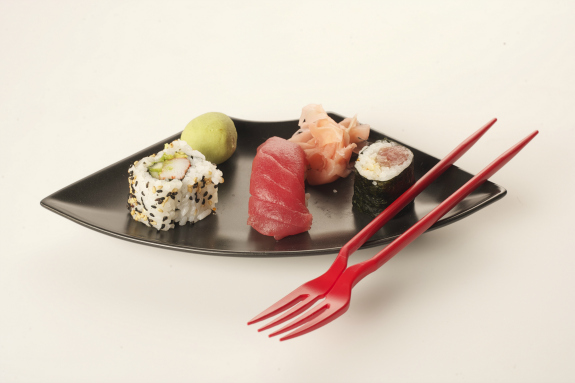What the Heck is a Chork?
The new trend of modifying cutlery has a new look with the Chork, which combines the scandalous fork with age-old chopsticks

The Chork. Photo courtesy of B.I.G.
In today’s global village, it should come as no surprise that Eastern and Western cultures are often wedded, and sometimes in weird and ingenious ways. Enter the Chork. While it may sound like an expletive, or a clever name given to the odd guttural noise produced when an over-zealous chortle leads you to choke, it is neither.
The Chork is an innovative new eating tool that combines chopsticks with a fork. It is the brainchild of Jordan Brown, who saw the need for the Chork at a sushi dinner when he found himself constantly reaching for a fork while eating with chopsticks, to grasp smaller grains of rice. Brown, a partner at the concept development and marketing company Brown Innovation Group Incorporated (B.I.G.) in Salt Lake City, then resolved to make the transition between the fork and chopsticks easier with the Chork.
With chopsticks on one end and a fork on the other, you’re bound to ask why you didn’t come up with this simple yet brilliant innovation yourself. Keeping in mind that most people need to use a fork because they haven’t quite mastered the art of using chopsticks, Brown has designed the Chork such that the adjoining sticks can be pinched together to grasp food without needing to be separated, functioning as trainers. For the initiated, the sticks come apart and click back into place just as easily.
When we wrote before about the origins of the fork and chopsticks, little did we imagine that these implements with such diverse and storied histories could be blended so harmoniously. The fork, the younger of the two, is said to have caused quite a stir when it was first introduced:
In 1004, the Greek niece of the Byzantine emperor used a golden fork at her wedding feast in Venice, where she married the doge’s son. At the time most Europeans still ate with their fingers and knives, so the Greek bride’s newfangled implement was seen as sinfully decadent by local clergy.
Chopsticks, in contrast, had a more humble beginning:
The earliest versions were probably twigs used to retrieve food from cooking pots. When resources became scarce, around 400 BC, crafty chefs figured out how to conserve fuel by cutting food into small pieces so it would cook more quickly.
While it took two years in the making for the prototype of the Chork to undergo several revisions, the final product finally hit the shelves early last year. “People are really interested to see something new and unique, especially in a part of food service that hasn’t really had a lot changes. The utensils that you use to consume your meal have been the same for forever, so I think part of it is just the novelty of having a different tool with which to eat your food, really gets people excited,” says Nick Van Dyken, general manager of the Chork.
Receiving rave reviews from Gizmodo blogger Casey Chan who goes as far as to say that “the chork, instead of pandas, could be used to maintain US/China relations,” and Daily Mail writer Ted Thornhill who writes, “this new kid on the utensil block is certainly proving a hit with diners,” the Chork seems to have made an impression. But it is left to be seen how lasting that will be. For now, this versatile tool has made inroads to dethroning the simple fork. According to Van Dyken, the utensil is available at grocery stores on the East Coast, the Atlantis resort in the Bahamas, and Carnival Cruise Ships. Here in D.C., the PhoWheels food truck distributes them in lieu of more traditional utensils.
The Chork has inspired a spinoff from B.I.G., namely, the creation of a spoon version of it, tailored to accompany the many soup-based Chinese and Vietnamese dishes, which should be available early next year (the Choon, perhaps?).
Cutlery might have been slow to change thus far, but the tide is turning. Another newcomer that seeks to find room on your table is the Trongs. This claw-like device was created to help grip finger foods while avoiding the mess. No longer will finger-lickin’ good wings or ribs require just that.